CRL Reports: Site 8SJ3478 – Lab Work Update
Lab Work Update: 24 February 2000
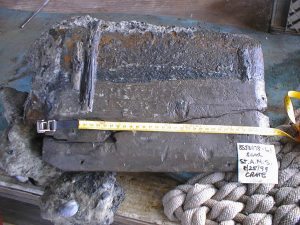
Work in the lab this month has been focused on the continuing "excavation" of artifact # 8SJ3478-61, one of three wooden boxes recovered during the 1999 field season.
When discovered in situ this box had only two of its wooden side panels remaining. The box was upside down and a concreted mass of ferrous artifacts was "spilling" from the bottom.
The photo right shows the box after one of the wooden sides was cleaned mechanically to allow for x-ray analysis. The bands around the box are withy. Though the fasteners are gone, impressions left in the wood show the withy was attached with wrought iron tacks that ranged between 0.25 cm and 0.40 cm square at the top of the shank. The holes where fasteners were used to seal the box measure 0.5 cm square.
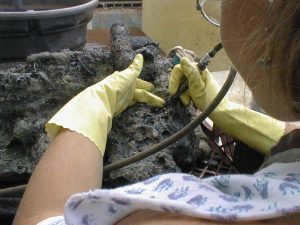
Next the box was flipped and the contents were photographed. After documentation, an air scribe was used to begin the painstaking process of separating the mass of ferrous corrosion products and concretion that encrusts the box's contents so that the individual components of the artifact may undergo separate procedures for conservation, as well as analysis. Recovered first from the very surface were twenty-three .69 caliber lead shot (8SJ3478-61-01). The next item recovered was one of two brass straight pins (8SJ3478-61-02). The photo at left gives an idea of the scale of the work.
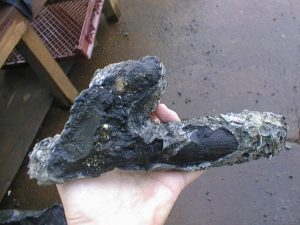
Artifact 8SJ3478-61 after recovery.
The next object removed from the box was an encrusted mold of an iron tool (8SJ3478-61-03, with a wooden handle strengthened by an iron band or ferrule still intact. After x-ray analysis the object will be cleaned mechanically and the mold cast with epoxy resin to recover the surface of the original tool. The right hand image shows artifact 8SJ3478-61-03 after recovery.
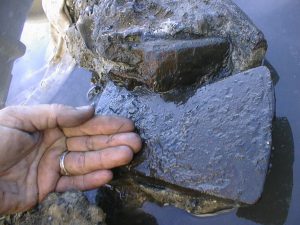
Artifacts 8SJ3478-61-04,05 - two axe heads exposed
As cleaning continues the surface of two axe heads have been exposed (8SJ3478-61-04,05). The axes appear to be felling axes that were in very good condition at the time of their loss. Their cutting edges are flat, not sharpened to a bevel. More will be determined after the axe heads are completely excavated and recorded. The image at left shows the axe heads and the brass pin.
Lab Work Update: 17 May 2000
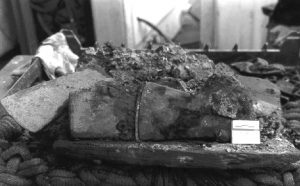
Box 8SJ3478-61 before separation of artifacts
The separation of artifacts in Box 8SJ3478-61 has been completed. At final count, fourteen American style felling axes, seventeen brass straight pins, one silver button, and the encrusted tool shown above (8SJ3478-61-03) were removed from the broken box. The axes were packed carefully into place, alternating from blade to poll. Several of the axe heads are stamped "R BOYD".
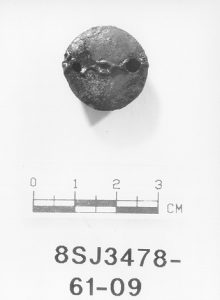
Silver button recovered from one of the boxes.
The button was recovered from between two of the axe heads in the box, next to the scale in the view shown above. It is silver, with no apparent markings. There are two holes on the reverse face of the button, as well as a crushed loop.
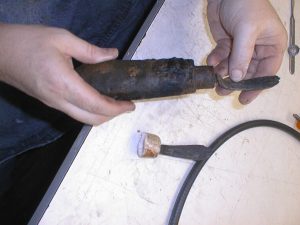
Cleaned artifact, similar to a tuck trowel of today.
Artifact number 8SJ3478-61-03 was shown above in its concreted form. The object was concreted to the axe heads in Box 61. The artifact has been cleaned of concretion and identified as a tool. A mold has been made in order to replicate the iron portion of the tool that was too degraded to preserve. The tool is some sort of trowel with a very small, rounded blade, for smoothing. It is most similar to a "tuck trowel" in modern tool catalogues.
The photo shows the tool being cleaned and reassembled after casting. The handle is wooden, and the blade was held into place by an iron ferrule. Although the ferrule had completely degraded, a mold remained in the encrustation that allowed a cast to be made matching its original dimensions
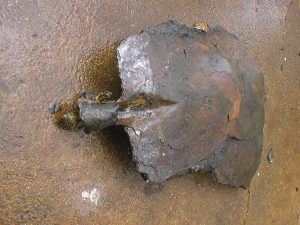
Remains of shovel blades which were encrusted to the cannon.
The final cleaning of the remains of a large concretion (8SJ3478-30) that was encrusted to the six-pound cannon recovered in 1998 has revealed nine shovel blades. Some of the blades have lost all of their metal content, and have been drawn and cast only. A few blades have enough iron remaining to undergo electrolysis.
The swivel gun, 8SJ3478, has undergone a final mechanical cleaning before continuing treatment in electrolysis. The area around the yoke has been cleared. What was originally thought to be a wedge, has proved to be a part of the yoke assembly. One side of the yoke was split in two at the Y, drawn back through and hammered flat.
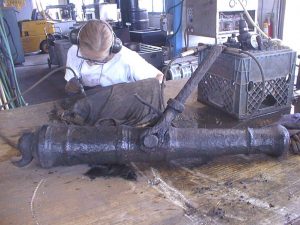
Swivel gun during mechanical cleaning prior to undergoing electrolysis.
There are no markings at all on the gun barrel. Though swivel guns of all shaped and sizes were ubiquitous on merchant vessels during this time period, the 8SJ3478-39 swivel gun and yoke assembly are remarkably similar to a gun recovered from Lake Champlain (see Bass, Ships and Seafaring, 1976:300). Although recovered later, the gun was probably from one of two French ships scuttled in Cumberland Bay in 1759 (Kevin Crisman, personal communication 2000, and Dennis Lewis, "An Interim Report on the History of the Sloop Boscawen", September 1984 for the Fort Ticonderoga-Champlain Maritime Society).
The French vessels had been attempting to reach their fort at "Ile-aux-Noix". This provides a second possible tie to the British Army operating in New York. It has been suggested that the "Illinoise" that marks the boxes of axes (8SJ3478-59 and 60) may be an anglicized version of "Ile-aux-Noix". Ile-aux-Noix was destroyed by British forces in 1760. British Public Record Office (PRO: WO 34/51 and 34/51 96) documents contain correspondence to Amherst which describe the British efforts to recover the stores, cannon, and a "quantity of iron" from Ile-aux-Noix dated 30 October, 1760. Further research is ongoing.
Lab Work Update: 2 June 2000
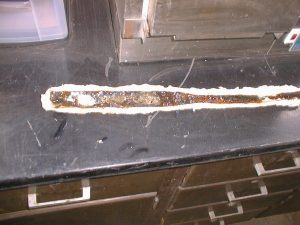
A possible lathing gouge (8SJ3478-53)
One other new tool type that has recently been discovered in the artifact encrustations that have been cleaned to date is a 1" gouge made of iron, possibly a lathing gouge (8SJ3478-53). Though some of the iron had completely degraded, a mold was used while cleaning to allow a perfect replica tool to be cast.
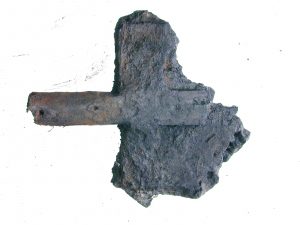
Concretion artifact number 8SJ3478-55, from a shovel
Artifact number 8SJ3478-55 is a concretion that has recently been cleaned. In between two shovel blades that have completely degraded, the remains of a broken wooden haft has been mineralized. The fastener markings detail the shape of the missing socket and show how the shovel blade would have been attached. A mold is currently being made to allow the creation of a cast replica of the shovel blade that may be attached to the wooden handle.
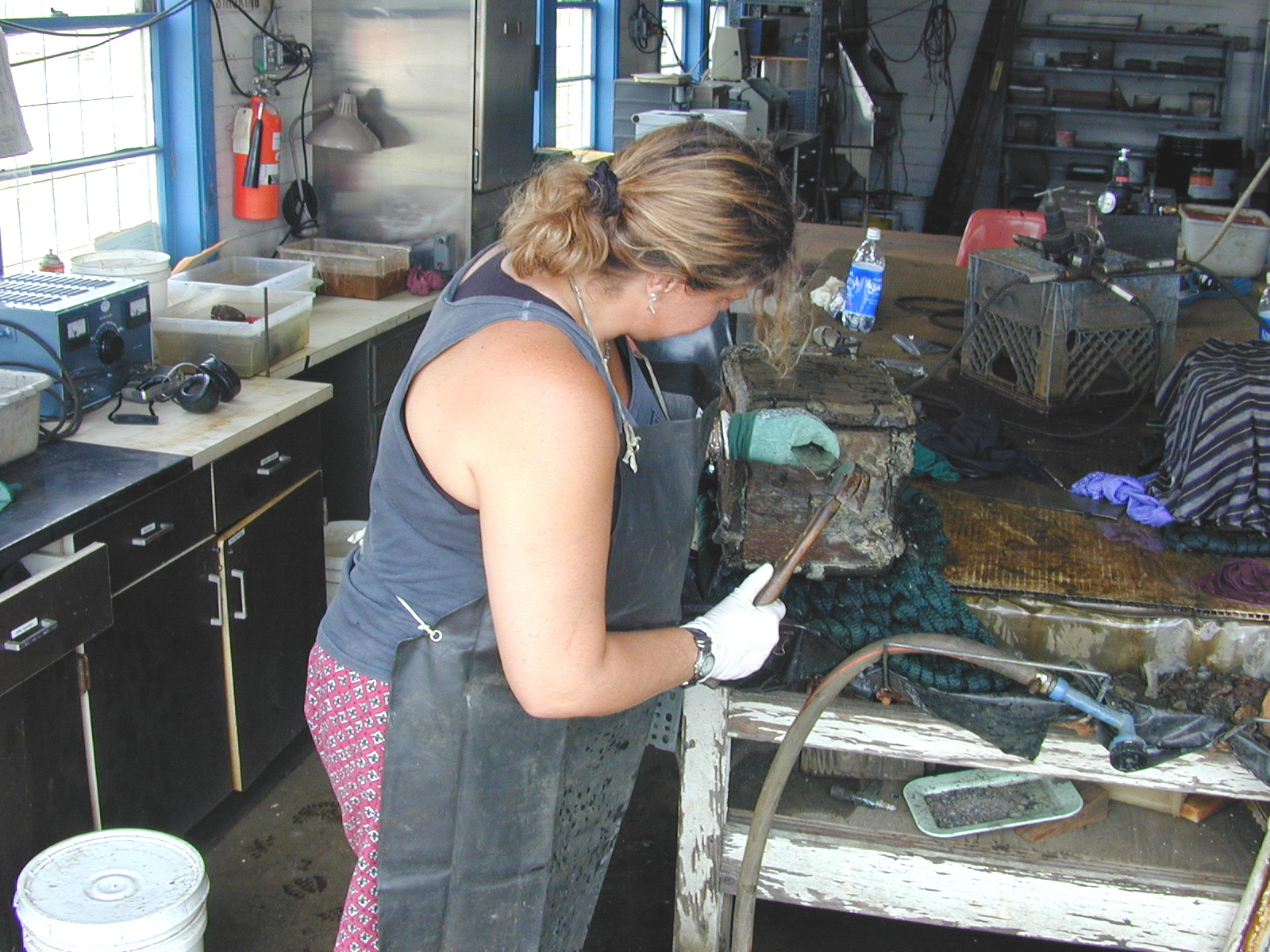
The majority of recent work at the lab has been focused on the two remaining sealed wooden boxes, numbered 8SJ3478-59 and 8SJ3478-60. The lids have been carefully removed after cleaning, revealing the contents.
As labeled, both boxes contain twenty American style felling axes. This makes a total of fifty-four identical axe heads that have been recovered from the site.

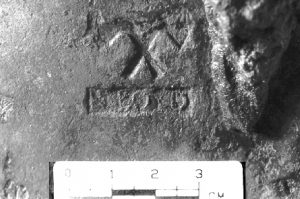
Makers mark stamped on an axe head, showing two crossed axes.
The majority of the axes are stamped with a makers mark. Above the name "R BOYD" is a second stamp that shows two crossed axes.
Box 60 has been completely cleaned and emptied in preparation for conservation treatment. Work on Box 59 is ongoing.
Citation Information:
Franklin, Marianne
2000, Site 8SJ3478, possibly the Industry: A British 18th-Century Shipwreck, Conservation Research Laboratory Research Report #10, World Wide Web,
URL, https://liberalarts.tamu.edu/nautarch/crl-reports-site-8sj3478/crl-reports-site-8sj3478-lab-work-update/ . Nautical Archaeology Program, Texas A&M University
